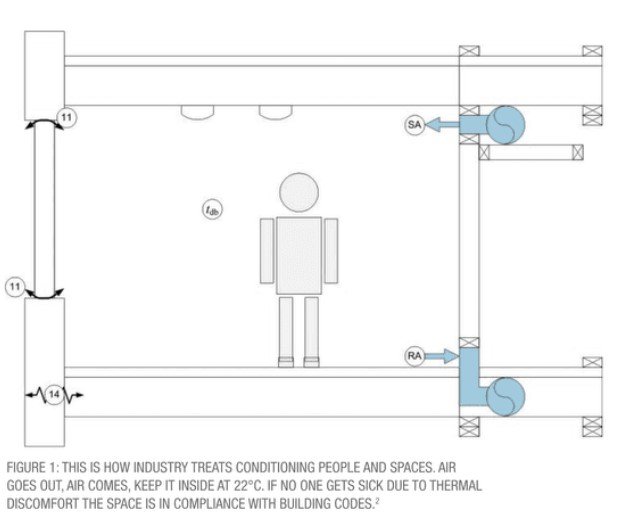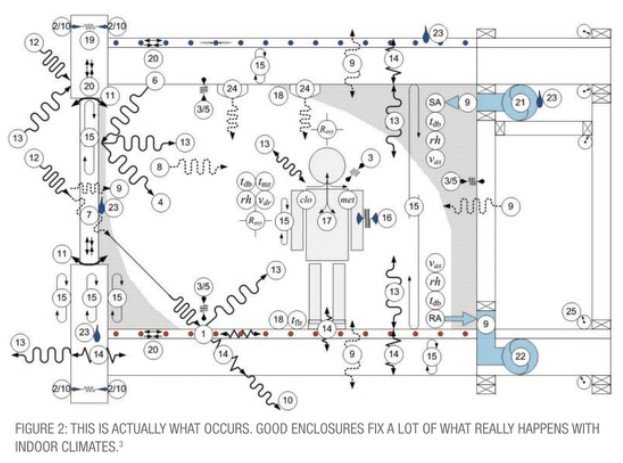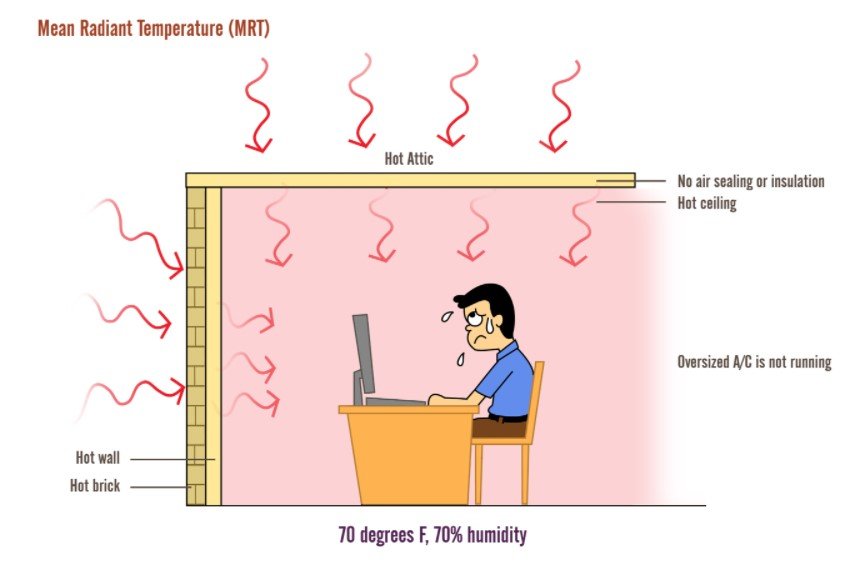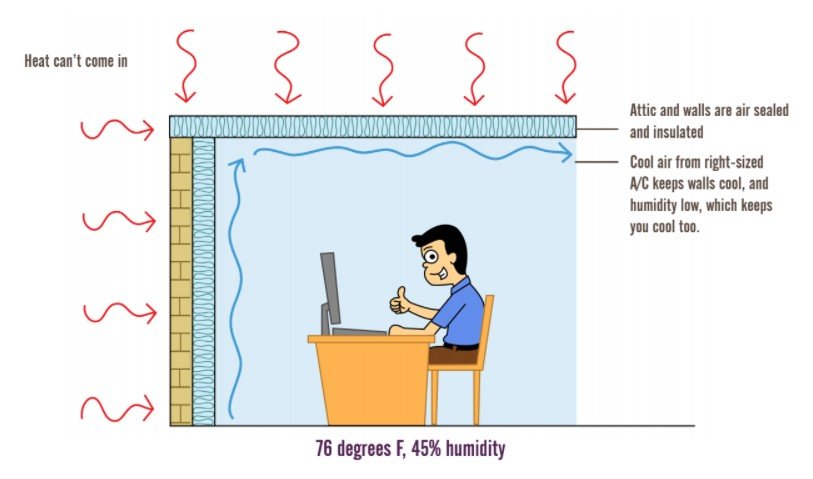Get Tech Tips
Subscribe to free tech tips.
Mean Radiant Temperature: What It Is and Why We Should Care
Our industry puts a lot of emphasis on the “AC” (air conditioning) part of HVAC. We specialize in maintaining and servicing a wide variety of simple to complex air distribution systems. But we’re really in the business of comfort—human comfort and health, to be precise. So, just how much does the human body rely on air movement for comfort?
We know the four methods of heat transfer:
- Conduction (direct contact with an object—like water or a hot coffee mug)
- Convection (air movement)
- Evaporation (energy used to change liquid water to vapor)
- Radiation (infrared waves in contact with a surface or surrounding air)
Of those four methods, the human body transfers heat using the following percentages:
- Conduction: ~3%
- Convection: ~15%
- Evaporation: ~20%
- Radiation: ~60%
Source: Anatomy & Physiology II / lumenlearning.com
Of all the methods of heat transfer, our industry spends most of its time laser-focused on the one that makes up only 15% of the human body’s overall heat transfer! This is largely due to the way codes are written, as they expressly use the term “air” temperature to describe the medium that must be controlled. Below is an example of how most of the industry believes comfort works vs. what actually occurs in an occupied space.


Source: “Integrated Design Illiteracy: The Root of All Evil in Architecture” by Robert Bean; used with permission
As you can see, the way heat transfer occurs inside buildings is much more complex than the way we sometimes treat it. But if the air temperature is the wrong thing to focus on, what’s the alternative?
Nate Adams defines mean radiant temperature (MRT) as “the average temperature of all the surfaces around us.” Basically, the temperature of our surroundings has more to do with how we feel than air temperature alone because we are constantly either absorbing heat or radiating it from our bodies.

Source: The Home Comfort Book: Home Comfort 101 by Nate Adams used with permission
If we as technicians begin to shift our focus on the radiant or operative (as Robert Bean likes to call it) temperature, we will start solving problems we previously didn’t even know existed. Things like air leakage, poor insulation, oversized equipment, inadequate air exchange rates, etc., become more obvious once we widen our perspective to include our bodies’ main heat transfer method.

Source: The Home Comfort Book: Home Comfort 101 by Nate Adams
But 99% of all thermostats installed in a building measure air temperature, right? So, how do we actually measure MRT? Robert Bean, R.E.T., P.L. outlines three different methods for measuring MRT, each with increasing levels of accuracy and complexity. Here, we will look at the easiest method; it may not be the most accurate, but it is a great way to begin measuring MRT in any building for a general idea of the actual comfort of the space. This method is known as the MRT Proxy Method (MRTpm). The formula is as follows:
MRTpm = (Tu-1 A1 + Tu-2 A2 + … Tu-nAn ) / A1 + A2 + …An
Where,
Tu = temperature of the surface, ℉/℃
An = area of the surface, ft2/m

Source: Bean, Robert. (2020). Thermal Comfort Principles and Practical Applications for Residential Buildings.
The thermostat in this example is reading 72℉ air temperature, yet the operative temperature (how we actually feel in the space) is ~64℉! There are more nuances to the MRT Proxy Method that account for windows and doors. However, this simple example gives us a general idea of how we can calculate the mean radiant temperature on the fly in a building. For more information on the other methods for measuring MRT, check out Robert Bean’s book, Thermal Comfort Principles and Practical Applications for Residential Buildings HERE.
An awareness of the fact our bodies primarily use radiation for heat transfer allows technicians to begin to utilize different methods to control mean radiant temperature. Some strategies include reducing solar load by suggesting exterior shading, air sealing the envelope of the building, adding insulation in certain areas, etc.
None of this is to say that our specialization in air distribution and conditioning systems is irrelevant. Convection is still about 15% of the human body’s mode of heat transfer. Yet, HVAC contractors are seen as responsible for providing and maintaining quality comfort in a healthy indoor environment. To deliver on this responsibility effectively, a closer look at what really happens inside a home/building is necessary. A well-designed, right-sized heating/cooling system with a leak-free, properly designed and installed duct system is critical for healthy indoor air quality and adequate air exchange rate. But it’s a mistake to think the mechanical appliance alone is enough to handle all the comfort needs for occupants inside a building.
Next time you get the call for a home or business with a complaint that the space is too warm or too cool, don’t limit your observations to just the mechanical system. You may very well find an oversized system, a poor duct design, or some other strictly HVAC-related problem. But you may also find additional issues related to the building envelope itself, which, if left unresolved, will continue to make any issue with the HVAC more noticeable/critical. When all the expectations/load for comfort has been thrown on the appliance, it will be impossible to provide and maintain true thermal comfort inside any space.
—Kaleb
Additional Resources:
- http://www.healthyheating.com/Definitions/Mean%20Radiant.htm#.YKaTCKhKiM9
- http://www.healthyheating.com/
- http://www.healthyheating.com/Thermal-Comfort-in-Simple-Terms.htm#.YKaDW6hKiM8
- https://view.imirus.com/1166/document/12309/page/9
- http://www.healthyheating.com/Thermal-Comfort.htm#.YKVXc6hKiM8
- https://courses.lumenlearning.com/suny-ap2/chapter/energy-and-heat-balance/#:~:text=The%20body%20can%20also%20gain,transfers%20heat%20via%20infrared%20radiation.
- http://www.natethehousewhisperer.com/comfort-guides.html











Comments
Thank you for this informative article. I believe we need to understand emissivity of the materials in our interior to study comfort situation.
Thank you for this informative article. I believe we need to understand emissivity of the materials in our interior to study comfort situation.
To leave a comment, you need to log in.
Log In